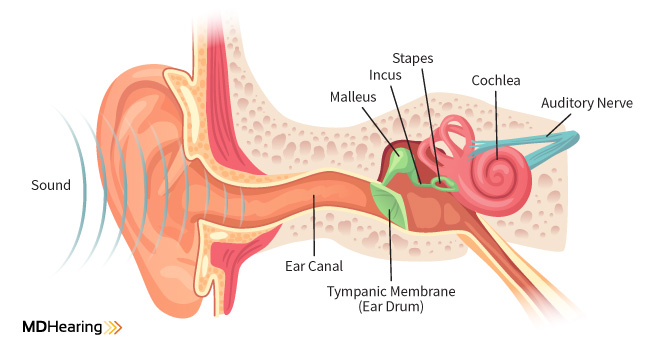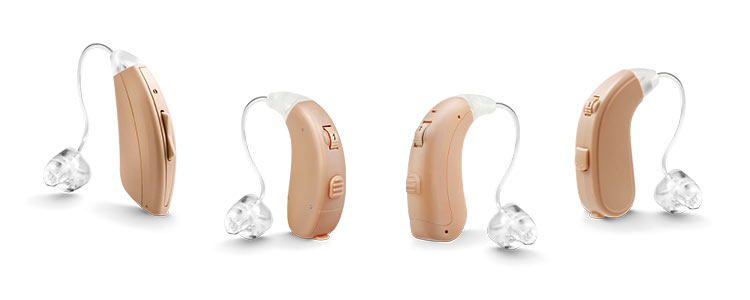So you found out that you have sensorineural hearing loss, but what does that mean exactly? Simply put, sensorineural hearing loss means that the tiny hair cells in your inner ears are damaged – either that, or the nerves that connect your brain to your ears – aren't working properly.
This is the easiest way to define sensorineural hearing loss (SNHL), which can reduce your ability to hear and makes it difficult to understand what your loved ones are saying. Unfortunately, the condition is permanent – and that's why audiologists recommend hearing aids when SNHL is bad enough.
But why do you have sensorineural hearing loss? Was it the loud machinery at work? Was it the music you listened to as a kid? And more importantly, is there a cure?
In this guide, we'll answer all of your questions about sensorineural hearing loss – while helping you understand what life is like for people with this condition. We'll also explore the possible causes of SNHL, and give you some medically-proven and affordable treatment options from MDHearing.
Please use the following links to navigate:
- Understanding Sensorineural Hearing Loss
- The Causes of Sensorineural Hearing Loss
- What It’s Like to Live With SNHL
- Sensorineural Hearing Loss Treatments
Understanding Sensorineural Hearing Loss
Before describing sensorineural hearing loss in-depth, we need to explore how the normal hearing process works. The easiest way to understand the hearing process is to divide it into the following steps:
1. Sound waves travel through the air: Sound waves are just air molecules bouncing off each other. They travel through the air – coming from the source of the sound – like waves in the ocean.
2. Sound waves enter the ear: When a sound wave enters your outer ear, it goes through the ear canal to the eardrum, which vibrates in harmony with the sound wave.
3. The eardrum transfers the sound vibrations to the “ear bones”: There are three tiny bones in the middle ear (the malleus, stapes, and incus). These ear bones move in response to the eardrum vibrations.
4. The ear bones turn the sound vibrations into “fluid vibrations”: The moving ear bones create “fluid vibrations” inside the cochlea. The snail-shaped cochlea is found in the inner ear, and it is filled with fluid.
5. The hair cells in the cochlea move with the fluid vibrations: Inside the fluid-filled cochlea are the tiny hair cells responsible for hearing. As the fluid vibrations pass through the cochlea, the hair cells move in harmony with the vibrations.
6. The hair cells create electrical signals: As the hair cells move and bend, small pore-like channels open and close, and special chemicals pass through the openings. This creates a chemical reaction that produces an electrical signal.
7. The auditory nerve delivers the electrical signals: The auditory nerve picks up these electrical signals and delivers them to the brain. After the brain receives the signal, it processes and interprets the "sound" that you hear.
Patients with sensorineural hearing loss are experiencing one of the following scenarios that interrupt the above-described hearing process:
- Damage to the tiny hair cells in the inner ear: When the hair cells suffer damage, they can't create the right electrical signals for clear hearing.
- Damage to the auditory nerve: When the auditory nerve suffers damage, it can't deliver sufficient electrical signals to the brain for clear hearing.
- A mix of both: A combination of hair cell and auditory nerve damage intensifies the hearing loss to create more hearing difficulties.
The level of damage to the hair cells and auditory nerve will determine the amount of sensorineural hearing loss (mild, moderate, moderately-severe, severe, or profound). The type of damage will determine the affected frequencies. Some people could lose the ability to hear high-pitched sounds, low-pitched sounds, middle-pitched sounds, or all three. Unfortunately, once the hair cells or auditory nerves suffer damage, they do not grow back. Your diminished hearing capacity is usually permanent.
The best way to judge the nature and extent of your hearing loss is to test your hearing. Try this free, five-minute, online hearing test from MDHearing. This test can’t provide you with a professional SNHL diagnosis, but it’s an excellent way to start evaluating the potential severity of your hearing loss to determine whether you may need hearing aids, and whether you may want to go to a professional for an in-depth evaluation.
Key points: The hearing process works as a series of steps. Sound vibrations enter the ears. The eardrum and ear bones transfer the sound vibrations into fluid vibrations inside the snail-shaped cochlea. The fluid vibrations cause the hair cells to move inside the cochlea, and this triggers a chemical reaction. The chemical reaction creates an electrical signal that travels along the auditory nerve into the brain. The brain understands the sound.
With SNHL, damage to your tiny hair cells and/or auditory nerve interferes with the normal hearing process. Unfortunately, the condition is permanent, and most patients with SNHL do not recover their hearing. The nature and severity of SNHL will vary from person to person. This free online hearing test from MDHearing is an easy way to measure your current hearing ability.
The Causes of Sensorineural Hearing Loss
Many factors contribute to sensorineural hearing loss. Doctors generally categorize these factors based on whether you have “acquired” or “congenital” sensorineural hearing loss. Acquired means that you developed hearing loss after birth, and congenital means that you were born with hearing loss.
Acquired Sensorineural Hearing Loss Causes
Acquired hearing loss develops after a person is born. In fact, 1 out of 5 people will develop some form of acquired hearing – so if you develop SNHL as you grow older, you’re not alone! Here are the most common causes of acquired sensorineural hearing loss:
- Aging: Approximately 33% of adults between the ages of 65 to 74 will develop age-related hearing loss as the hair cells in their ears deteriorate due to aging. Because it happens gradually, many patients do not notice the effects and they wait up to ten years before seeking treatment.
- Loud noises: Exposure to an extremely loud noise like a gunshot or explosion can result in hair cell damage that causes SNHL. Also, any prolonged exposure to noises louder than 85 decibels can permanently damage hearing. This could include the loud music you listened to as a kid or the loud machinery noises you endured at work. If you have ever left a loud concert and had the feeling of cotton balls in your ears, you might have suffered the kind of noise-induced hearing loss (NIHL) that leads to SNHL.
- Diseases and infections: A wide variety of infections can result in permanent damage to your hearing ability – including viral infections like meningitis, mumps, and measles. In the times of COVID-19, there have been numerous reports of irreversible sudden sensorineural hearing loss (SSNHL) as a result of coronavirus infections.
- Acoustic trauma and head trauma: A severe strike to the head – or an extremely loud noise at close proximity to the head – can damage the parts of the inner ear or brain responsible for hearing. This is why many veterans develop sensorineural hearing loss. One study found that veterans with combat experience have a 63% increased risk of hearing loss.
- Medications: Hundreds of medications – including certain anti-inflammatories, antibiotics, and chemotherapy treatments – are classified as “ototoxic.” This means that they can damage your hearing. Some of these medications are directly related to tinnitus (ringing in the ears).
Congenital Sensorineural Hearing Loss Causes
Congenital sensorineural hearing loss happens at birth or in the womb. The condition can result from maternal diabetes, hypoxia (lack of oxygen), premature birth, genetic conditions, and diseases like rubella that can spread to the baby during pregnancy.
Universal newborn screening practices – and more recently genetic screening – look for sensorineural hearing loss in newborns. Through early detection, newborns can receive hearing aids or cochlear implants to support their language learning process.
What Caused My Sensorineural Hearing Loss?
In most cases, a doctor won’t be able to determine whether your sensorineural hearing loss is noise-induced, age-related, disease-related, or medication-related. That means you’re never really going to know if the cause was listening to loud music or just a natural part of getting older or a combination of both.
That being said, a doctor might be able to pinpoint the exact cause of your sensorineural hearing loss if it happens immediately after a disease condition, infection, trauma, ear abnormality, or after taking a medication known to cause hearing loss.
It’s also important to note that patients can suffer from sensorineural hearing loss and conductive hearing loss at the same time (this is called mixed hearing loss). In the case of mixed hearing loss, it’s dangerous to assume that a rapidly-worsening hearing condition is a part of your “normal” hearing loss. That’s why it’s important to seek medical assistance as soon as you experience any sudden change in hearing. Sudden sensorineural hearing loss (SSNHL) – which results in the quick onset of noticeable deafness or hearing loss in one or both ears – could be a signal that you have a serious underlying condition.
Barring these exceptions, the best way to view your SNHL is that it’s just a normal part of getting older. The longer we live, the more chances we have of experiencing any number of the SNHL causes listed above.
Key points: The majority of sensorineural hearing loss cases are “acquired,” which means the hearing loss develops after birth as we age. The most common causes of SNHL are aging, noise exposure, disease, infection, trauma, and medications. It’s difficult for a doctor to pinpoint the exact cause of someone’s SNHL. However, those who experience a sudden change in their hearing should immediately see a doctor to determine if they have conductive hearing loss or a more serious underlying condition.
What It’s Like to Live With Sensorineural Hearing Loss
SNHL interferes with the clarity and loudness of sounds. Certain frequency ranges such as higher-pitched sounds are easier to hear than others. Men with lower-pitched voices at lower frequencies might sound clear, while women with higher-pitched voices at higher frequencies might sound like they’re mumbling – or it could be the opposite!
Here are the big red flags:
- Trouble keeping up with group conversations
- Swears everyone around them is mumbling
- Struggles to hear high-pitched voices (including women and children)
- Ringing in their ears (known as tinnitus)
- Dizziness and problems with balance
You might notice an increased sensitivity to certain sounds. Softer voices and sounds leave you frustrated, while louder voices and sounds are agitating. As you try to get the right balance, you are continually asking people to raise or lower their voices, and frequently adjust the volume on the television or radio.
Alternatively, your symptoms could be as simple as having a hard time understanding what people are saying. This can be exhausting because no one talks loud enough for you to understand – especially at restaurants, churches, parties, and large gatherings. Many people with SNHL miss important parts of conversations.
If you’re hanging back from conversations and not fully participating – or if you’re avoiding social gatherings because you don’t understand what people are saying – you might want to consider getting treatment for hearing loss.
Key points: Living with SNHL isn’t easy – neither for the person who has it nor for the family members and friends who love them. If you suspect that you are suffering from any kind of hearing difficulties, get treatment immediately. It will dramatically improve the quality of your life.
Sensorineural Hearing Loss Treatments
There are a number of proven techniques that can moderately improve your brain’s ability to understand sounds and voices without hearing aids. However, the physical damage to the ear that causes sensorineural hearing loss is permanent. Hearing aids are the only way to experience an immediate improvement in hearing when you suffer from sensorineural hearing loss.
As the most common treatment recommended for people diagnosed with sensorineural hearing loss, hearing aids can instantly boost the clarity of the speech and sounds around you.
Along with helping you hear better in general, hearing aids take away that mental strain of trying to focus on your friend's voice or the dialogue on the TV. They can help you be more aware of your surroundings, which is crucial during emergencies. And while there's no cure for this type of hearing loss, hearing aids can help you maintain the hearing you still have. It's really a smart investment towards your overall quality of life both now and in the future!
MDHearing: Affordable, Medically-Proven Hearing Aids
One of the biggest reasons people put off buying hearing aids is because they can be very expensive, especially if you buy them through the hearing clinic with their many mark-ups. Most people just don't have thousands of dollars to spend on hearing aids.
Luckily, there are plenty of affordable, high-quality, FDA-registered hearing aids available from online, direct-to-consumer hearing aid manufacturers like MDHearing. Hearing aids from MDHearing cost between $399 and $999 a pair (not thousands of dollars). Best of all, MDHearing products are medical-grade and doctor-designed, and they fit everything from mild to moderately severe sensorineural hearing loss.
Check your hearing for free with this 5-minute hearing test.
TAKE ONLINE HEARING TEST
Interested in starting a completely risk-free trial with MDHearing? Check out our different models for yourself.
BROWSE HEARING AIDS



